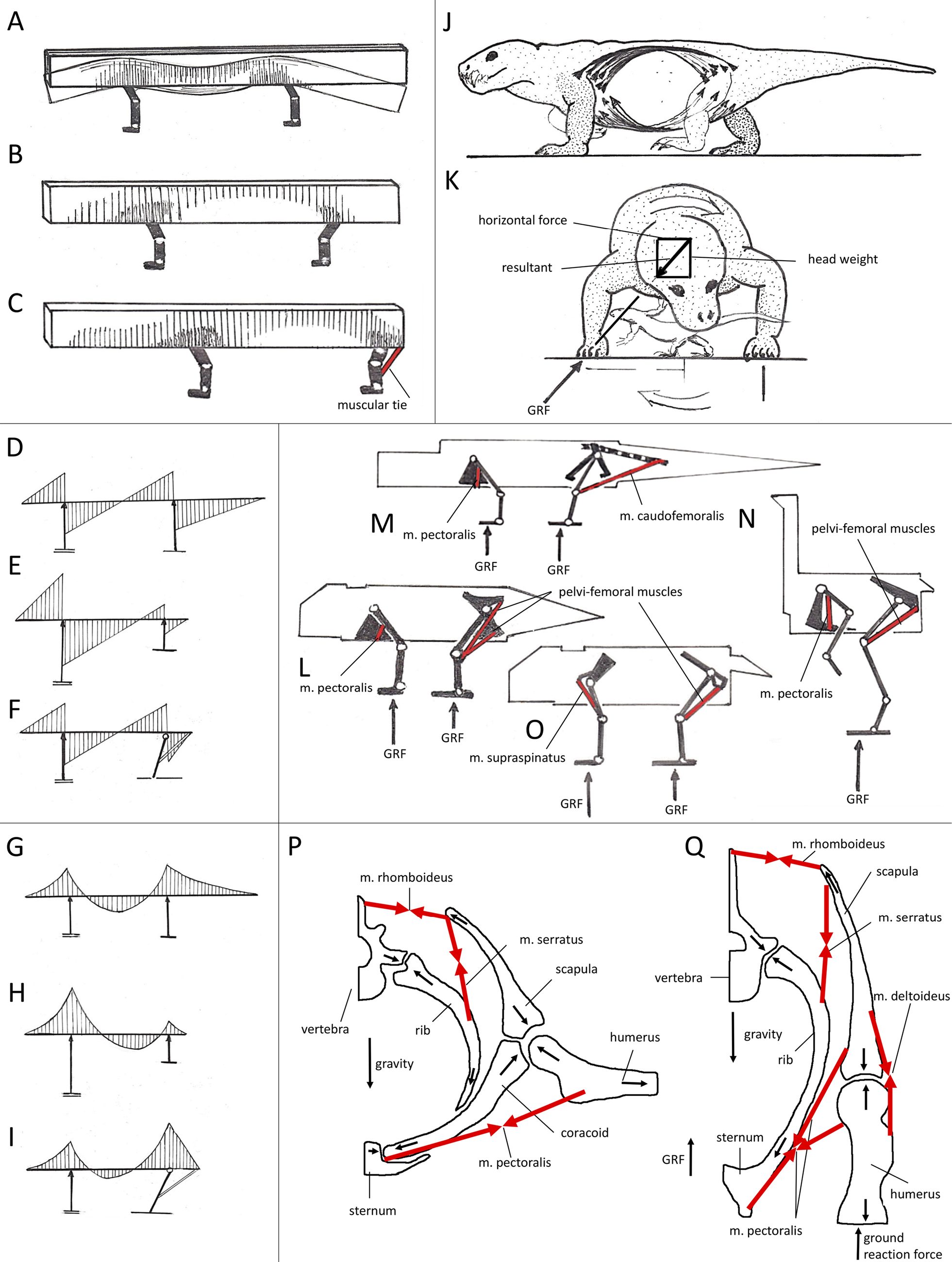
|
||
|
A–C Body-stem simplified as a beam, resting on two pairs of supports at equal distances. Sketches based on finite element structure analysis-models. The trunk is assumed to have two times the weight of the head and neck and the tail. If the beam consists of soft material, gravity deforms it as shown in A. A Head and tail bend downwards and the trunk sags in the middle imposing tensile and compressive stresses onto the model. Compressive stress, vertically hatched; tensile stress, hatched horizontally. B The tail is reduced like in some therapsids. Only the compressive stresses are shown because the compression-resistant skeleton is the only preserved material we have. The highest values are indicated by darker hatching. The highest forces occur along an arch reaching from the anterior support along the back to the posterior support. That means the shoulder blade should be inclined posterodorsally and the ilium should be inclined anterodorsally. C Head and neck are elongated (which has the same effect as a heavier head in combination with a shorter neck) and the tail is completely reduced. The posterior support is connected to the trunk by a joint, which must be balanced by a muscular tie (double line). The pulling force causes very high stress in the beam behind the joint. D–F Transverse forces of the same beam. D Shows an equal amount of functional loading distributed onto the fore- and hindlimbs, and the long tail. E The combination of a short tail and a heavy head results in high loads on the fore limbs like in many therapsids. F A high load on the hindlimbs results from a forward inclination of the latter, like in the majority of mammals. The inclined limb is kept in balance by a muscular tie which connects the limb with the trunk. This leads to high transverse forces in the posterior cantilever. G–I Bending moments in the beam shown above in A, B, C The bending moments are the products of the transverse force at a certain length multiplied by distance to the nearest support. Therefore, their arrangement along the length of a body shows curvilinear outlines. Above the supports, positive values are high, between the supports, the sign changes, and reaches its lowest point where the transverse forces cross the zero line. G Long tail, stress peaks are about equally high, the highest negative values reached a maximum near the middle of the trunk. H Short tail and heavy skull result in a higher stress peak above the fore limb than in the hindlimb. I The hindlimb is inclined and balanced in the joint by a muscular tie. This results in very high transverse forces caudally to the joint, which create a very marked stress peak and reduce the negative values between the supports. J, K Torsional moments. J During locomotion between anterior and posterior extremities in the trunks of quadrupedal tetrapods. Torsional stresses concentrate near the external body wall and create a space free of functional loadings, i.e., the body cavity. K Torsion also occurs in the neck of therapsids, e.g., during feeding. The weight of the head combines with the horizontal force component to a resultant, in line with the sprawling legs, which reaches the ground within the area of support, otherwise the animal would fall over. L–O Different patterns of loading the extremity girdles. In M reptiles, N birds, O mammals, and L Therapsida. Skeletal elements black, active muscles red. Ground reaction force (GRFs) indicated by upward directed arrows, the length of which is roughly proportional to the size of the respective force. In M crocodilians and lepidosaurs, the retraction of the femur is performed by m. caudofemoralis. In N Aves, O Mammalia, and L Therapsida, femoral retraction is performed mostly by pelvi-femoral muscles originating from the pelvis caudally to the acetabular joint (ilium in Therapsida, ischium in Mammalia, synsacrum in Aves). Reptiles, synapsids, and birds have in common that the shoulder joint is balanced mainly by a very strong m. pectoralis. In mammals, the scapula is suspended by e.g., the m. supraspinatus. P, Q Suspension of the body stem from the pectoral girdle in cross section. P In reptiles, Q in cursorial mammals. P Please note that the most anterior ribs of reptiles primarily provide the insertion area for the m. serratus (which carries the body stem). Q In mammals the anterior ribs close the circle of forces via their rigid connection to the sternum. The m. pectoralis of mammals suspends the body and aids in keeping the glenoid joint in balance (changed after Hohn, 2011). Abbreviations: GRF, ground reaction force. |